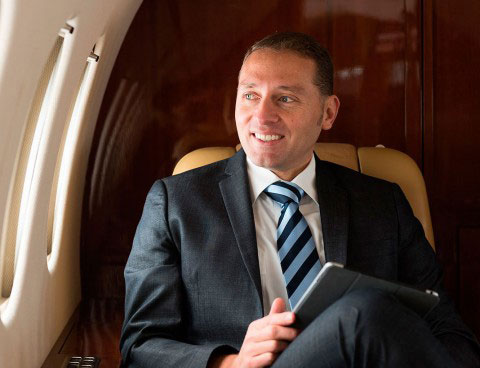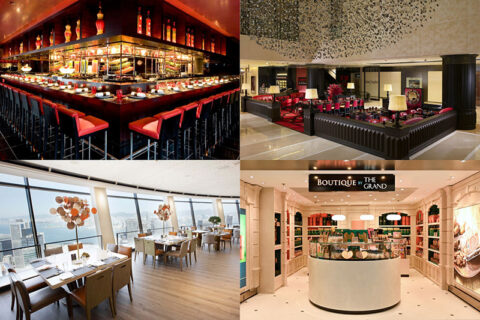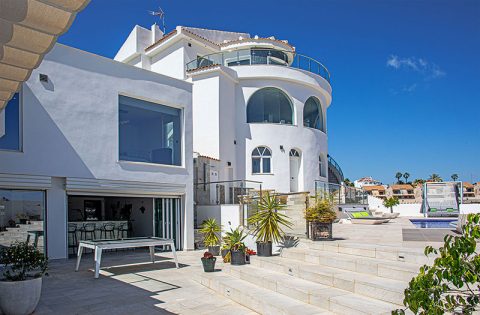Martial Widemann is a veteran Swiss pilot with over sixteen years in the airline industry. He is also an entrepreneur and humanitarian as seen in his startup expressions. He is the CEO of Moonlight Air, an airline service that provides non-commercial scenic flights. He doubles as the President of the Executive Flight Club and Project Manager of Moonlight Air Foundation. We had a chat with him recently about his aviation business, the flight club, and the Foundation. Read on to know more about this innovative entrepreneur from Switzerland.
Martial shares on the idea behind Moonlight Air and his vision for the business here.
How did the idea to begin Moonlight Air come to you?
I just completed my basic pilot training 2001 and was ready to apply for professional aviation. However, after 9/11 and the grounding of Swissair, more than 500 highly experienced pilots lost their job just overnight. Furthermore, it was not the golden age of European airlines. Many of them moved into the red at this time and to find an airline hiring a trainee was tough, if not impossible. I had two choices; stop my further professional training or move ahead and pay all training up to the last airline pilots license by myself, which came up to $200,000 that time. Not an easy decision for a 21-year-old guy whose dream was flying since an age of four. Giving up was never an option for me, but also not to take the financial risk of sitting on a huge mountain of debt without a job guarantee as a young man who’s life just began. So I had to be realistic and decided to freeze my plans. I did continue to fly, though, to build experience and to keep my basic pilot license valid by doing small training steps to reduce financial risks. Everything I invested up to that point was my saved money. I was not rich at all also not my family, so I had to find a solution on how to finance my further flying education with my small income as a cook. Since I had a private pilot license only, I was not allowed to get paid or hired for flights. That was when the idea came up to offer non-commercial scenic flights for individuals who just had to pay for the flight time and not for the pilot. I started doing it and got other pilots to do it the same way. Because with this model, pilots in similar positions like me or professional pilots who lost their job, could continue flying, building experience and keep the license current for better times. So I contacted our authority, shared my ideas and got permission. That was my first project and the beginning of everything that has followed.
What has it been like for you taking your idea from a start-up to a large company?
I built my business while I had a full-time job. So I was not in a rush and grew slowly but steady. Everything was learning by doing. I made my way through all sections over the years. I started from a one-person show, worked with part-time partners up to a small critical team as it is today. I started small with private scenic flights, followed by air taxi flights from inside Switzerland to European wide and later Intercontinental by starting as a business jet broker. In 16 years I have learned everything from organizing catering, how to get overflight and landing permissions, many things about maintenance, country-specific legislations, organizing entire executive travels with hotels, transfers, yachting, and others. Moreover, whenever possible, I was a part of the crew itself. I had good mentors and learned many things, and I am still learning every day.
What was the last year like in terms business viability for Moonlight Air?
My business is quite different from “competitors” because we operate aircraft for private owners, companies or even governments. Our owners do not charter out the aircraft at all. It means we do not have the pressure of being viable with a charter business. We manage a single aircraft or build up and manage an entire flight department for our clients. Every aircraft management is 100% individual as its owner is and therefore we are operationally independent and totally flexible regarding the whole setup, aircraft type, and its position.

What are your goals for Moonlight Air in 2017?
To move ahead with Moonlight Air Foundation by receiving financial guarantees and get ready for taking off.
How has your military training helped you thus far in your career?
During my time in the Swiss Army, I learned to hold together, to fight for others and then to look out for myself, to follow instructions and to implement my interest at the same time. I learned that the team was the most important as well as good food. No matter how bad or hard the times were, we always had a good time and problems were solved quickly. I learned to give up my control and to rely on others. It was an excellent preparation for my simple job as a pilot because these things are a daily business in the cockpit too. It was not only my military career as one of the youngest officers but also all my experiences up until then. I was always the youngest and sometimes the shortest person. I had to enforce myself to fight for my rights and finally for my dreams. Moreover, I never give up.
How has the jet chartering niche grown in the last 15 years you have been in business?
It was growing nearly continuously with the highest peak in the early millennium followed by a crash in 2008 because of the financial crisis. Since 2010 the market is increasing slowly again. Inside the jet sector business, you find light jets, mid-size, large and cumbersome aircraft. Every industry was affected in a different way and later developed differently. Overall I can say that the most stable situation we recognized was in the large and heavy aircraft segment. However, the situation in 2008 was a game changer. Many operators struggled and went out of business, others merged, and a few started a new business and came out with the right idea at the right time. Today you find companies selling jet cards, empty legs, aircraft shares or ownerships. So there is not really a niche charter market anymore, except an operator offers something special, e.g. point-to-point scheduled flights with a business jet. 10-15 years ago an operator was able to generate revenue for the aircraft owner with any business jet. Since 2008 this wish has become a complete illusion, the highest of highs will be a black zero at the end if you are lucky.
Why the name ‘Moonlight Air’?
That is a question I always get asked. The name was born out of a situation, something I saw and felt. It was one of such a “yes – this is it!” moments. I had this idea with the scenic flights while watching the stars in the sky. I saw an aircraft crossing the moon and this moment was the beginning of what it is today. Today I am quite happy about this name because it is such a different name in a positive way. It is unpolitical and ethically neutral. At the same time, the moon has something mystical, it calms and inspires you. It is just something everyone has kind of a connection to everywhere in the world.

Martial also explained what the Executive Flight Club is in the interview below.
What inspired the creation of the Executive Flight Club?
Today you can buy favorable hour packages for a particular aircraft, but with less availability, therefore you probably cannot fly at your convenience. Alternatively, buying a jet card which is limited on usage may also lead to losing money if you do not use the hours purchased within a particular time. It is also often bounded on a two or three-year contract. The next step is you try to manage your flights on the empty leg market. However, you will find yourself paying the full cost most of the time because the aircraft does not fly the route you need nor the time you may look for. After all the effort, you decide to buy an overpriced aircraft share at a large operator; you get an aircraft which is too large or too small, a grumpy crew to fly with or a bad service. Finally, you will contact two or three aircraft operators to receive information about an airplane ownership – and now welcome to the shark tank! If you have a good operator you made a lucky punch, if not you will be cheated from the beginning till the end. Moreover, once again, one more unhappy aircraft owner is jumping from one commercial operator to the next one year after year until he gets completely banned from aircraft ownership. That is the reason why I created Executive Flight Club to demonstrate that everything is highly transparent, fair and professional from the idea to own an aircraft up to buying, operating and trading or selling an aircraft.
How do you balance the leadership of Executive Flight Club with your other initiatives?
After all years of owning and growing my companies and projects, we are still familiar with one another, and I like to keep that size. I like to maintain the overview of all things going on by giving my key team the freedom to choose what they like to do next. Thanks to the concept that every jet management is an independent company for itself, the particular crew is in charge to handle the situations as they approach. I am in charge only in case of tough situations. This makes me able to fly, manage and handle the important things personally while I have my representative inside of every team for all other cases. This comes back to your earlier question about what I have learned during my time in the army; to give up my control and rely on others. Doing this can be an inspiration for the employee. In the end, we all want to have a satisfying life with a varied work which fills you with joy and happiness.

What criteria do you employ in selecting staff for the Executive Flight Club?
There are no differences regarding the criteria in team selection between the Executive Flight Club and Moonlight Air. We do not follow a strict screening process like airlines or other operators do. The personality of each employee has to match with our expectations and how he or she will fit into the existing team. For an aircraft owner, it makes a huge difference if he trusts two pilots who know each other very well and act as a team or if he has two pilots with personal or cultural differences.
Why is a maintenance of absolute discretion essential in this work?
Wealthy people like to reduce the public interest to a minimum. Nobody should know when he or she is traveling nor where he or she are going and who is attending. They have confidential discussions with business partners, work onboard the aircraft or even sleep in their pajamas. We see them like they are at home on board. They can be themselves. That is why privacy and discretion are so important. My first client purchased a 10-hour flight package for a small single engine aircraft 12 years ago. He was the first one who asked for a long haul private jet flight, and now he owns a business jet which we manage today. We are growing together, and this is what I like, to build and develop something that will endure.
What can you say to inspire young pilots who are where you used to be?
An aviation career today is entirely different than it was 15 or 20 years ago. Today many universities offer an aviation degree which is great. Personally, I would start flying at a very young age in a sailplane. The sooner you get your wings, the better it is for your next step. Whether you apply for a “cleared direct” education, military flight training or want to study aviation management, figure out first what you like more: Flying a big airliner like a bus driver or flying a private jet with personal contact to your passengers and to be responsible for everything. In aviation, you need to be flexible and open-minded. You have to act anticyclical, and you will also need a plan B all the time. Moreover, the most important thing you have to remember is: as soon as you receive your pilot license, you have permission to fly. However, you will keep on learning with every hour you are sitting on the plane. Obtaining a license is only the beginning of this lifelong adventure.

We were also curious about the Moonlight Air Foundation and asked Martial about it. Here are his thoughts.
How many aid cases has Moonlight Air Foundation handled since its inception?
We have not started yet; the Foundation has a project status, and we currently are seeking for investors. We are finished with all the planning and ready to take off within six months after financial guarantees are secured. With the Moonlight Air Foundation, we can support NGOs and humanitarian organizations around the world with a large cargo aircraft. We become active in case of natural catastrophes, for sustainable humanitarian aid, for medical intervention and in areas of crises. Based on our concept we expect several flight missions weekly to improve people’s healthcare, support local industry and people’s lives where needed. At the same time, we coordinate the goods we transport and use synergies between the various organizations.
Can you explain your missions bit closer?
On average, every day 2.6 natural catastrophes happen somewhere on the planet. Of course not every disaster needs an immediate action, but in the case of the “zero hours,” you need an available aircraft which is ready for taking off within hours. Not only after one or two days as it is today at most NGOs. With the humanitarian aid, we like to support people around the world in a sustainable way with food, agricultural and construction material, equipment, medication, and others; to build shelter, houses, drinking fountains and water systems. At the same time, we stimulate the local industry. The “flying mobile hospital” will include a container system where Western medical professionals can execute eye, heart and other surgeries, wholly independent of location or local situations.
What costs are we talking about for such a flight mission?
First of all, we do not charge any cent from humanitarian partner organizations. They should use their donation money for aid materials and not for transportation costs. If they do not have to spend money on these expenses, they can buy more support material which the foundation then will deliver point-to-point where help is needed. A single charter flight costs between $10,000.- and $30,000.- per hour. For example, one single flight mission from Europe to Haiti – executed by a commercial airline – easily costs $250,000 or more. Humanitarian organizations pay hundreds of thousand dollars every year just to transport aid. Now think about how many tons of goods they can provide with $250,000. Therefore our idea is to cover all operational costs by investors/sponsors.
What is your greatest joy starting and running Moonlight Air Foundation?
It is about doing something good and helping people around the world. Imagine you transport 60-100 tons of relief supplies in a disaster area and hundreds or thousands of people waiting for the urgently needed aid. Alternatively, if you pick up the mobile hospital after a three-month mission, you would have helped dozens of adults and kids, being able to see again or being helped with a life-saving heart surgery. It is about supporting people and making their lives better. Bringing the aid to places where it is needed and helping people to build up a better life. Seeing and experiencing that as you CAN contribute to making the world a better place is priceless.
What is your philosophy of changing the world?
Money makes the world go round. However, honestly, it is just crazy how and where people spend huge sums of money. Let’s take Super Bowl Commercials as an example: for being present 30 seconds on the big screens, companies are willing to pay 30 million dollars. Alternatively, look at famous athletes: Real Madrid was paying 100 million pounds for the transfer of soccer player Cristiano Ronaldo. Alternatively, Western Governments spend millions for advertising campaigns against food waste every year. On the other hand, there are so many people suffering and living in poverty everywhere in the world.
Imagine the huge change we all could make in this world by just putting a minor amount of all that money into projects like the Moonlight Air Foundation. To operate this foundation, we need investors who are ready to provide at least $250 million. It sounds like a lot but with this amount we can run for ten years and help millions of humans around the globe. This project will be able to show that money spent in the right place will make a huge difference.
What is your five-year projection for Moonlight Air Foundation?
To think five years ahead is a short period in aviation. You should think 7-10 years ahead if you want to build something sustainable. That is also the reason why we are looking for financial guarantees for a minimum of 10 years, just to be flexible enough to react immediately and independent. My personal goal for the first five years is to reduce the global drinking water problem, increase global healthcare and to find more investors. Additional money allows us to continue building up the second stage of the Foundation and to secure flight operation for the following 10-20 years.
How do you think the government should approach natural disasters and political unrests?
As long as there are politicians, who impose their will to other states, suppress their people or just follow their own economic and financial interest, there will only be little changes. Humans want to develop themselves, but they get intentional wrong information to keep them down and stupid. Two examples: experts say that most of the CO2 in the atmosphere were produced by aircraft. However, if you believe the figures and facts provided by the industry, cars produce 10x more CO2 than aircraft. So why do governments not support electro cars? Because someone is losing much money and hundreds of thousands will lose his or her jobs. Also, our nature is changing but not mainly because of us but because of natural cycles. Some 450 million years ago the amount of CO2 in the atmosphere was ten times higher than it is today and about 1,000 years ago, the sun had the same activity as today, and it was hot everywhere. Politicians and people need to recognize and understand what is going on instead of closing their eyes in front of the reality. Our planet needs solutions and not delusions.
How has been the response of other charities and investors to the initiative?
We have received many positive feedbacks from various humanitarian organizations. After two days we had a letter of intent from a large worldwide and well-known organization. We also received an agreement from a government regarding a partnership to execute their flights. Within few weeks we won over one organization after the other, and we are sure there will be even more as soon as we go public with the details if the financial guarantee is secured. One thing is sure: we hit the pulse of time. There is not only demand, but there is also a real need of what we plan to do. The only mile we have to go now is to find individuals or companies who support this foundation. We are currently building up connections and are in real hope to start talks soon.

Here is the story of a man who rose from practically nothing to become a change agent who determines his destiny. Talk about some major inspiration! We are touched by what Martial has done with his aviation businesses and foundation. We hope that he will be successful in all his endeavors here on. Much thanks to you the reader for following!
www.moonlightairfoundation.org











